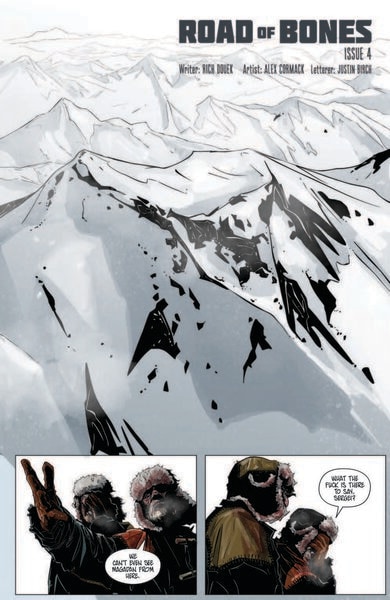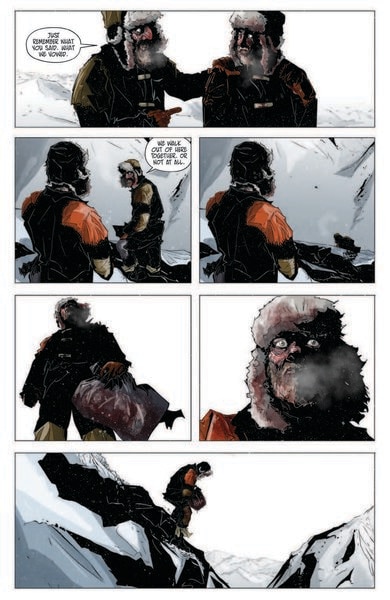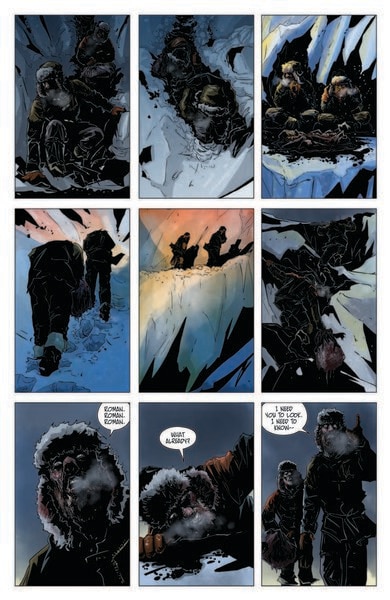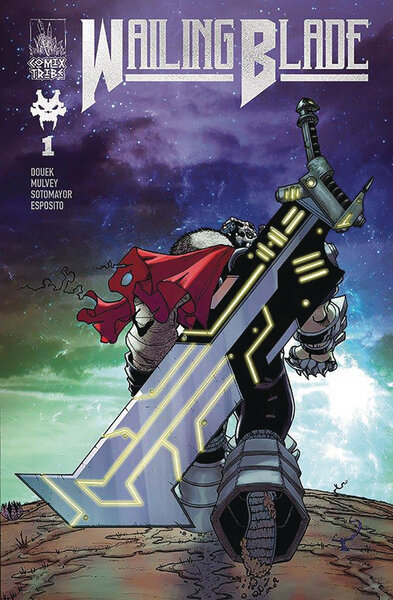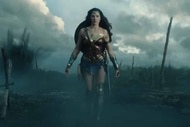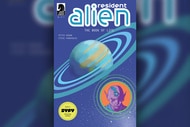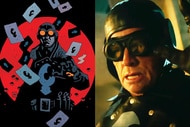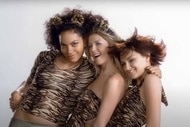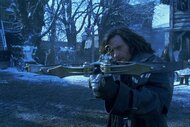Create a free profile to get unlimited access to exclusive videos, sweepstakes, and more!
Road of Bones creator Rich Douek on the human horror that inspired his dark tale
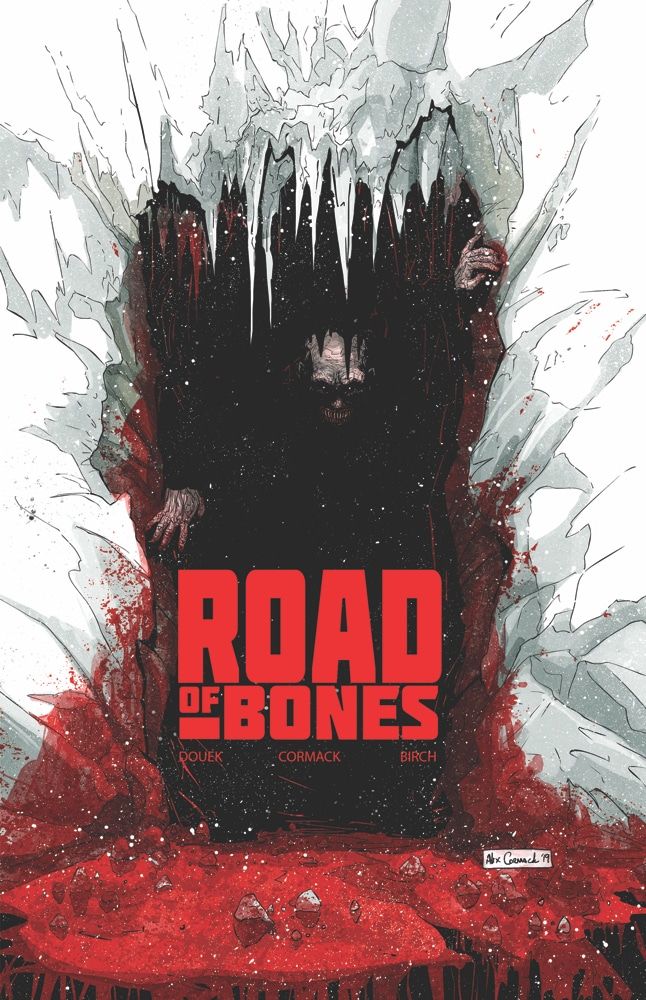
Road of Bones is a story that's primed for a film adaptation but has thus far been executed pitch-perfectly as a horror comic book. Its premise: In the tundra of the Siberian Gulag in 1953, Roman Morozov seeks to escape his sentence to hell. Joined by two other escapees, he embarks on hundreds of miles of a savage, frozen wasteland with limited resources and a spirit watching over them. IDW Publishing has sold out of multiple printings of each issue, and the story is gaining steam.
SYFY WIRE had the chance to enjoy a conversation with writer/co-creator Rich Douek about his frigid thriller.
Any time you have a story set in the snowy winter, it's a great setting for a horror story. This story was inspired by Russian folklore, right?
Douek: In part, yeah. The Road of Bones is a real place. There was this horrific Gulag system under [Joseph] Stalin, where they had these work camps in Siberia. There were all of these huge mining operations, and weren't many roads to get there. So, one of the main projects of the Gulag was to build a road to move materials back and forth, and it was done by slave labor, basically, with political prisoners.
The reason it's called the "Road of Bones" is that it's literally like the first two pages of the book, where if a prisoner dies, instead of digging a grave for them, they literally roll them into the foundation of the road, which is something they actually did. They were digging in permafrost, and the ground was frozen solid. Digging a grave would take up too much time. It was one of the most horrific real-life situations. You could change nothing about what actually happened and it would still be a horror story. So I wondered if there was another level I could push the story to off of that, to make it even more horrifying to explain the human condition under extreme conditions.
So the folklore part of the story comes with the creature that Roman is leaving food for, right?
Douek: Yes. As there are in many folklores, there's this notion of, like, a house or guardian spirit. In Russian it's called a "domovik," and in Celtic mythology it's called "Brownies" or "Pucks." We all know the fairy tale of the shoemaker elves, spirits that live in your home, and if you are nice to them, like leaving them some food, they make sure nothing bad happens to you. Some find religion, or a silly bit of superstition, but I thought, maybe if you lived in this situation, you're imprisoned, hopeless, and you have nothing to cling to, maybe this absurd little hope would be the one thing you clutch onto.
There's such an air of despair in the pages of this story; the tone is heavy, and a lot of that comes through the art by Alex Cormack. What did you develop with him on the look of Road of Bones?
Douek: It's something that Alex brought a lot to the table. We did talk a lot about what we wanted to accomplish with the art. One thing is that all the characters are ugly in their own way. It goes against the look of superhero books, where we see people who are paragons of beauty and perfect physicality. So these guys stand out to show that they're in a rough situation that is wearing them down. You also see the progression as they go on their journey. By Issue #3, they're a lot more gone than Issue #1, because of the lack of food.
The other thing is that when you have a lot of the people wearing the same uniform(s) or who are issued the same clothes, whether it be soldiers or prisoners, you want everything to be distinct, but you also want to honor the reality. So we had to talk about ways to differentiate with the colors of their clothing, like where Roman's jacket is orange and Grigori is blue. Another theme [we had to visualize] was the dehumanization that survival pushes you to. Where is the line you draw between being a human and a thing?
What about the great contrast you see between the stark, blank palette of snow everywhere the eye can see during the day, while night scenes look deliberately designed to be hard to see what's going on?
Douek: As far as the night and day sequences go, one of the great things that Alex does is that, for night, he almost starts with black and comes up from it. So he has just these edgy outlines. It feels like it's taking place at night. It's not like, if he were to color it differently, it would end up as daytime.
Did you think about the length of the series?
Douek: It's not that I couldn't do five or six issues, but so much of the story is them meandering bleak landscapes and scaling mountains and the vast wasteland. So I felt like another issue of just that felt like it was dragging out. I felt like I could push it as much as I wanted to without it getting overly repetitive.
Even though this story is coming out of the '40s and is ultimately set in the '50s, was there something that you felt was current about it?
Douek: It's not so much that there's something in the present-day news that I want to tackle through Road of Bones. There seems to be a wellspring of never-ending human cruelty. It's like a conscious thing to read about the Gulag and think about how we're incarcerating people at our border. This didn't come to light when I was writing it, although it wound up coming to light at the same time. It seems like, if we can look at these dark chapters of our history, even through the lends of a fictional story, that maybe we can look at our behavior in the present day to not let that happen again.
Let's dance around the pivotal third issue of the story, because it's a wonderfully crafted story. As you're writing out the scripts, and you know that's coming, you also know you have to top this in Issue #4.
Douek: Specific to comic book storytelling, the last page of every issue is really important, because it tees up the next issue, especially in a series that is tightly structured like in Road of Bones. So I tried to have a revelation on the last page to make you want to see what happens in the next issue. I told Alex that the last page of #1 was the best of the series until I saw the last page of #2, only to be topped by the last in #3. He gets that idea of setting up the question that is going to be answered in the last issue.
You're walking this line where you have three guys walking into the woods without any food, you know what's going to happen [laughs], or you have a good idea of what's going to happen. It's inevitable that things go the way they do, but, at the same time, you want to approach it so that it's surprising and engaging. I knew from the second I wrote down the story in its simplest form where things were going, but how were we going to get there, how were we going to get in their heads of these characters and come along with them for the ride? How are we going to get you to feel the horror?
You have another creator-owned title that is currently out called Wailing Blade, how that's been going?
Douek: It's another four-issue mini-series. The Wailing Blade is this over-the-top science fiction set thousands of years in the future, with giant swords and executioners tearing heads off [laughs]. On the surface, Wailing Blade and Road of Bones are really different, but when you dig a little deeper, they have some similarities that I didn't catch: They both deal with people living under tyranny and responding to it. It's funny to realize there are these things that work their way into your writing when you're doing it. Those things are on your mind, because you want to talk about it, but it works its way into your work even though you're not consciously setting out to do it.
It originally started as a Kickstarter and was successful. It made three times what we were asking for, and it made enough to fund the entire printing of the series. I think we're going to do another Kickstarter in the fall for a hardcover or softcover collected edition packed with goodies in the back.
What I learned on this campaign is that we did a lot more preparation and things tailored to the Kickstarter audience, where there's some overlap of folks going to comic shops and those that just buy comics on Kickstarter and that's their main comics outlet. We had Tyler James of ComixTribe helping to run our campaign, who has a podcast called ComixLaunch, which is this great resource for anyone looking to launch a Kickstarter comic. I encourage anyone who is thinking of going that route to research when to reach out to people, how and if to budget for Facebook ads or Twitter ads. Those aren't the sexy parts of making comics, but if you want to meet your goal and not waste your time, it helps to make it as successful as possible.
Be sure to check out our six-page preview of Road of Bones below and head to the comic shops now for the full story!
